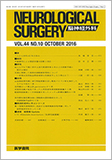Japanese
English
- 有料閲覧
- Abstract 文献概要
- 1ページ目 Look Inside
- 参考文献 Reference
Ⅰ.はじめに
頚部内頚動脈や総頚動脈内に血栓が形成され塞栓源となることは稀であるが,以前より報告されている1-5,11,12).特に血栓が可動性である場合はfree-floating thrombusとも呼ばれ,脳塞栓の発症に注意が必要となる2,4,5).血栓の発生機序については,動脈硬化性狭窄病変を伴う場合は内膜損傷部より発生し増大するものと推測されている.これに対して,狭窄病変を伴わない場合は凝固機能亢進状態を伴うことが多いと報告されている2,12).
治療法については,抗凝固薬による薬物治療1)と頚動脈内膜剝離術3-5,8)や頚動脈ステント留置術11)などの手術治療が報告されているが,どの治療法をどのようなタイミングで選択するかに関しては,一定の見解は得られていない2,5,8,12).
今回われわれは,内頚動脈内血栓の症例に対して,一連の治療法として急性期抗凝固薬投与に続いて頚動脈内膜剝離術を行い,良好な転帰を得た.本症例について文献的考察を加えて報告する.
BACKGROUND:An intraluminal thrombus in the carotid artery is relatively rare. A high frequency of perioperative symptomatic stroke has been reported in patients undergoing carotid endarterectomy, and no standard therapy has yet been developed.
CASE PRESENTATION:A 69-year-old woman, with no history of trauma, presented with ischemic stroke and mild right hemiparesis. Computed tomography and MRI showed an infarction in the left parietal region. A carotid Doppler study showed carotid stenosis on the left side. Further investigation with digital subtraction angiography confirmed significant carotid artery stenosis with an intraluminal thrombus in the left internal carotid artery. She was treated with initial intravenous anticoagulant therapy followed by carotid endarterectomy with thrombus removal 14 days after admission(subacute phase). There was no postoperative complication and she had uneventful course over 3 years of follow-up.
CONCLUSION:Initial adjuvant anticoagulant therapy for symptomatic intraluminal thrombus followed by carotid revascularization is an effective surgical strategy. A meticulous surgical procedure is required to perform a carotid endarterectomy in patients with an intraluminal thrombus.

Copyright © 2016, Igaku-Shoin Ltd. All rights reserved.


